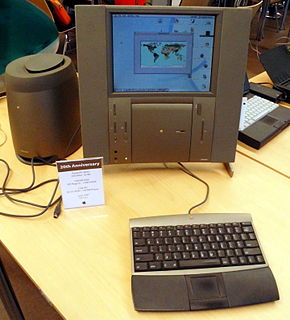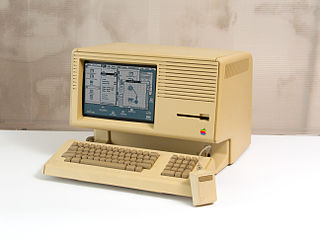
Lisa is a desktop computer developed by Apple, released on January 19, 1983. It is one of the first personal computers to present graphical user interface (GUI) in a machine aimed at individual business users. Development of the Lisa began in 1978, and it underwent many changes during the development period before shipping at US$9,995 with a five-megabyte hard drive. The Lisa was challenged by a relatively high price, insufficient software library, unreliable Apple FileWare ("Twiggy") floppy disks, and the immediate release of the cheaper and faster Macintosh — yielding lifelong sales of only 10,000 units in two years.

The Macintosh Plus computer is the third model in the Macintosh line, introduced on January 16, 1986, two years after the original Macintosh and a little more than a year after the Macintosh 512K, with a price tag of US$2599. As an evolutionary improvement over the 512K, it shipped with 1 MB of RAM standard, expandable to 4 MB, and an external SCSI peripheral bus, among smaller improvements. It originally had the same generally beige-colored case as the original Macintosh, but in 1987, the case color was changed to the long-lived, warm gray "Platinum" color. It is the earliest Macintosh model able to run System 7 OS.

The Macintosh SE/30 is a personal computer designed, manufactured and sold by Apple Computer, Inc. from January 1989 to October 1991. It is the fastest of the original black-and-white compact Macintosh series.

SuperDrive is a trademark used by Apple Inc. for two different storage drives: from 1988 to 1999 to refer to a high-density floppy disk drive capable of reading all major 3.5″ disk formats; and from 2001 onwards to refer to a CD/DVD reader/writer.

The Macintosh SE is a personal computer designed, manufactured and sold by Apple Computer, Inc. from March 1987 to October 1990. It marked a significant improvement on the Macintosh Plus design and was introduced by Apple at the same time as the Macintosh II.

The Macintosh Color Classic is a personal computer designed, manufactured and sold by Apple Computer, Inc. from February 1993 to May 1995. It is an all-in-one design, with an integrated 10″ Sony Trinitron display at 512×384 pixel resolution.

The Twentieth Anniversary Macintosh is a limited-edition personal computer released in 1997 to mark Apple's 20th birthday. The machine was a technological showcase of the day, boasting a number of features beyond simple computing, and with a price tag aimed at the "executive" market.

The Macintosh 128K, originally released as the Apple Macintosh, is the original Apple Macintosh personal computer. Its beige case consisted of a 9 in (23 cm) CRT monitor and came with a keyboard and mouse. A handle built into the top of the case made it easier for the computer to be lifted and carried. It had an initial selling price of $2,495. The Macintosh was introduced by the now-famous $370,000 television commercial by Ridley Scott, "1984", that aired on CBS during the third quarter of Super Bowl XVIII on January 22, 1984. Sales of the Macintosh were strong from its initial release on January 24, 1984, and reached 70,000 units on May 3, 1984. Upon the release of its successor, the Macintosh 512K, it was rebranded as the Macintosh 128K. This computer did not have a model number.

The Macintosh 512K is a personal computer that was designed, manufactured and sold by Apple Computer, inc. from September 1984 to April 1986. It is the first update to the original Macintosh 128K. It was virtually identical to the previous Macintosh, differing primarily in the amount of built-in random-access memory. The increased memory turned the Macintosh into a more business-capable computer and gained the ability to run more software.

The Macintosh XL is a modified version of the Apple Lisa personal computer made by Apple Computer, Inc. In the Macintosh XL configuration, the computer shipped with MacWorks XL, a Lisa program that allowed 64 K Macintosh ROM emulation. An identical machine was previously sold as the Lisa 2/10 with the Lisa OS only.

The Macintosh IIcx is a personal computer designed, manufactured and sold by Apple Computer, Inc. from March 1989 to March 1991. Introduced six months after the Macintosh IIx, the IIcx resembles the IIx and provides the same performance, but is seven inches narrower, ten pounds lighter, and quieter due to a smaller internal fan. The relative compactness results in three NuBus slots being available, compared with six on the IIx.
Larry Pina is an author of five do-it-yourself repair manuals for Apple Macintosh computers and peripherals. Pina authored the Mac shareware utility Test Pattern Generator (TPG) which allowed users to test and measure various video screen characteristics via test patterns. Among other circumstances, Mac users could use the TPG utility after performing hardware upgrades to check if the screen alignment needed adjusting. According to several of the books, Pina was living in Westport, Massachusetts when they were published.
The Dead Mac Scrolls is a 484-page do-it-yourself guide to repairing Apple Macintosh personal computer hardware problems in the most cost-effective way. Written by Larry Pina, the book was amongst other titles written by Pina for repairing Macintoshes. The book is out of print, and was first published in 1992.
Macintosh Printer Secrets is a 408-page hardcover book written by Larry Pina. It was first published in 1990 by Hayden Books, and is now out of print. The book teaches about dot matrix and ink-jet printers on the Apple Macintosh personal computers.
Macintosh II Repair and Upgrade Secrets is a 264-page hardcover do-it-yourself book written by Larry Pina that describes how to repair and upgrade a Macintosh II personal computer. The book was first published in 1991 and is now out of print. It came with a diskette.
Hayden Books was an imprint of MacMillan Computer Publishing USA that published computing books, with a particular emphasis on the Macintosh platform and desktop design. Several book titles written by Larry Pina were published by Hayden Books.
Goldstein & Blair Publishing was a publisher of Apple Macintosh-related books in the 1980s and early 1990s, including The Macintosh Bible. They also published one of Larry Pina's books.

The generically named Macintosh Processor Upgrade Card is a central processing unit upgrade card sold by Apple Computer, designed for many Motorola 68040-powered Macintosh LC, Quadra and Performa models. The card contains a PowerPC 601 CPU and plugs into the 68040 CPU socket of the upgraded machine. The Processor upgrade card required the original CPU be plugged back into the card itself, and gave the machine the ability to run in its original 68040 configuration, or through the use of a software configuration utility allowed booting as a PowerPC 601 computer running at twice the original speed in MHz with 32 KB of L1 Cache, 256 KB of L2 Cache and a PowerPC Floating Point Unit available to software. The Macintosh Processor Upgrade requires and shipped with System 7.5.

The Power Macintosh 7200 is a personal computer designed, manufactured, and sold by Apple Computer, Inc. from August 1995 to February 1997. The 90 MHz model was sold in Japan as the Power Macintosh 7215, and the 120 MHz model with bundled server software as the Apple Workgroup Server 7250. When sold as the 8200, it used the 8100's mini-tower form factor.

The Macintosh is a family of personal computers designed, manufactured and sold by Apple Inc. since January 1984.













